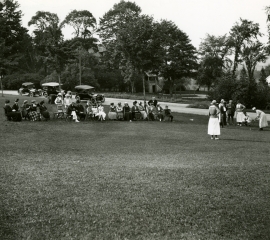SENIOR TORCHLIGHT CEREMONY, 1954
torches reflected in the icy Taylor Lake and symbolized the end of the long black-out of war. The commencement exercises were first held in 1955 in the Quadrangle instead of the Chapel to accommodate the larger number of graduates and their families and friends.
Alumni reunions, formerly occurring on commencement weekend, were moved in 1955 to the weekend after graduation. To give alumni greater opportunity to meet with members of other classes of their college generation a new reunion schedule was first put in use in 1956 which had worked successfully at Dartmouth since 1948. The flexibility of the program provided for celebrating the key 10th, 25th, 40th and 50th anniversaries of the exact year of graduation.
Colgate’s war service records, which Miss Alice I. Smith, formerly President Cutten’s secretary, meticulously kept up to date for the Alumni office, showed that approximately 3740 of the nearly 7,600 living alumni were in uniform and that there were 141 Gold Star men. One of their most notable morale builders for Colgate servicemen was the mimeographed Newsletter which William A. (Bill) Reid, ’18, Director of Athletics, edited and published. He drew on correspondence with them for much of his copy and sent his missive by first class mail to all corners of the earth. So far as is known, no other college provided its alumni with a similar vehicle of news and cheer.





